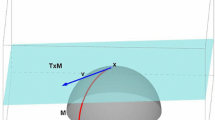Abstract
A novel algorithm called orthogonal discriminant local tangent space alignment (O-DLTSA) is proposed for supervised feature extraction. Derived from local tangent space alignment (LTSA), O-DLTSA not only inherits the advantages of LTSA which uses local tangent space as a representation of the local geometry so as to preserve the local structure, but also makes full use of class information and orthogonal subspace to improve discriminant power. The experimental results of applying O-DLTSA to standard face databases demonstrate the effectiveness of the proposed method.






Similar content being viewed by others
References
Donoho DL (2000) High-dimensional data analysis: the curses and blessings of dimensionality. In: Proceedings of the AMS mathematical challenges of the 21st century
Jolliffe IT (1989) Principal component analysis. Springer, Berlin
Turk M, Pentland A (1991) Eigenfaces for recognition. J Cogn Neurosci 3(1):71–86
Li H, Jiang T, Zhang K (2006) Efficient and robust feature extraction by maximum margin criterion. IEEE Trans Neural Netw 17(1):157–165
Duda RO, Hart PE, Stork DG (2001) Pattern classification. Wiley, New York
Belhumeour PN, Hespanha JP, Kriegman DJ (1997) Eigenfaces vs. Fisherfaces: recognition using class specific linear projection. IEEE Trans Pattern Anal Mach Intell 19(7):711–720
Tenenbaum J, de Silva V, Langford J (2000) A global geometric framework for nonlinear dimensionality reduction. Science 290:2319–2323
de Silva V, Tenenbaum J (2003) Global versus local methods in nonlinear dimensionality reduction. Adv Neural Inf Process Syst 15:705–712
Law MH, Jain AK (2006) Incremental nonlinear dimensionality reduction by manifold learning. IEEE Trans Pattern Anal Mach Intell 28(3):377–391
Roweis S, Saul L (2000) Nonlinear dimensionality reduction by locally linear embedding. Science 290:2323–2326
Saul LK, Roweis ST (2003) Think globally, fit locally: unsupervised learning of low dimensional manifold. J Mach Learn Res 4:119–155
Belkin M, Niyogi P (2003) Laplacian eigenmaps for dimensionality reduction and data representation. Neural Comput 15(6):1373–1396
Donoho D, Grimes C (2003) Hessian eigenmaps: new locally linear embedding techniques for high-dimensional data. Proc Natl Acad Sci 100(10):5591–5596
Weinberger K, Saul L (2004) Unsupervised learning of image manifolds by semidefinite programming. In: Proceedings of the IEEE international conference on computer vision and pattern recognition, vol 2, pp 988–995
Brand M (2003) Charting a manifold. Adv Neural Inf Process Syst 15:961–968
Zhang Z, Zha H (2005) Principal manifolds and nonlinear dimension reduction via local tangent space alignment. SIAM J Sci Comput 26(1):313–338
Coifman RR, Lafon S (2006) Diffusion maps. Appl Comput Harmon Anal 21:5–30
Lafon S, Lee AB (2006) Diffusion maps and coarse-graining: a unified framework for dimensionality reduction, graph partitioning and data set parameterization. IEEE Trans Pattern Anal Mach Intell 28(9):1393–1403
Lin T, Zha HB (2008) Riemannian manifold learning. IEEE Trans Pattern Anal Mach Intell 30(5):796–809
Lin T, Zha H, Lee S (2006) Riemannian manifold learning for nonlinear dimensionality reduction. In: Ninth European conference on computer vision, pp 44–55
Xiang SM, Nie FP, Zhang CS (2009) Nonlinear dimensionality reduction with local spline embedding. IEEE Trans Knowl Data Eng 21(9):1285–1298
Xiang SM, Nie FP, Zhang CS, Zhang CX (2006) Spline embedding for nonlinear dimensionality reduction. In: 17th European conference on machine learning (ECML ’06), pp 825–832
Yan S, Xu D, Zhang B, Zhang HJ, Yang Q, Lin S (2007) Graph embedding and extension: a general framework for dimensionality reduction. IEEE Trans Pattern Anal Mach Intell 29(1):40–51
Cai D, He X, Zhou K, Han J, Bao H (2007) Locality sensitive discriminant analysis. In: 20th International joint conference on artificial intelligence, pp 708–713
Chen HT, Chang HW, Liu TL (2005) Local discriminant embedding and its variants. In: IEEE conference on computer vision and pattern recognition, pp 846–853
Zhang TH, Yang J, Zhao DL, Ge XL (2007) Linear local tangent space alignment and application to face recognition. Neurocomputing 70:1547–1553
Li HY, Teng L, Chen WB, Shen IF (2005) Supervised learning on local tangent space. Lect Notes Comput Sci 3496:546–551
He X, Yan S, Hu Y, Niyogi P, Zhang HJ (2005) Face recognition using Laplacianfaces. IEEE Trans Pattern Anal Mach Intell 27(3):328–340
Duchene J, Leclercq S (1988) An optimal transformation for discriminant and principal component analysis. IEEE Trans Pattern Anal Mach Intell 10(6):978–983
Acknowledgments
This work is supported by the grants of the National Science Foundation of China, Nos. 60705007, 60805021, 60975005, 60873012, 60905023 and 60872113, and the Knowledge Innovation Program of the Chinese Academy of Sciences. The authors would like to thank all the guest editors and anonymous reviewers for their constructive advices.
Author information
Authors and Affiliations
Corresponding author
Rights and permissions
About this article
Cite this article
Lei, YK., Xu, YM., Yang, JA. et al. Feature extraction using orthogonal discriminant local tangent space alignment. Pattern Anal Applic 15, 249–259 (2012). https://doi.org/10.1007/s10044-011-0231-0
Received:
Accepted:
Published:
Issue Date:
DOI: https://doi.org/10.1007/s10044-011-0231-0




